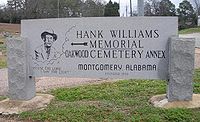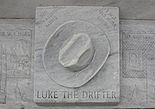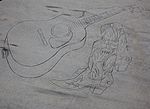- Death of Hank Williams
-
Death of Hank Williams
Entrance marker of the Oakwood Annex Cemetery in Montgomery, AlabamaLocation Oak Hill, West Virginia Date January 1, 1953 Hank Williams was an American singer-songwriter and musician regarded as one of the most important country music artists of all time. Williams was born with a mild undiagnosed case of spina bifida occulta, a disorder of the spinal column, which gave him lifelong pain—a factor in his later abuse of alcohol and drugs. In 1951, Williams fell during a hunting trip in Tennessee, reactivating his old back pains. Subsequently, he started to consume painkillers, including morphine, and alcohol to ease the pain.
Williams was scheduled to perform at the Municipal Auditorium in Charleston, West Virginia. Due to an ice storm in the Nashville area, Williams had to cancel the concert and hire college student Charles Carr to drive him to his next appearance, a concert on January 1, 1953, in Canton, Ohio. In Knoxville, Tennessee, they stopped at the Andrew Johnson Hotel. Carr requested a doctor for Williams, who was feeling the combination of the chloral hydrate and alcohol he consumed on the way from Montgomery. A doctor injected Williams with two shots of vitamin B12 that contained morphine. Carr talked to Williams for the last time when they stopped at restaurant in Bristol, Virginia. Carr later kept driving until he reached a gas station on Oak Hill, West Virginia, where Williams laying unresponsive in the backseat. After determining that Williams dead, Carr asked for help to the owner of the station who notified the police. After an autopsy, the cause of death was determined as, "insufficiency of the right ventricle of the heart."
Tributes to Williams took place the day after his death, the body was initially transported to Montgomery and placed in a silver coffin shown at his mother's boarding house. The funeral took place on January 4 at the Montgomery Auditorium, where an estimated 15,000 to 25,000 attended while the auditorium was filled with 2,750 mourners.
Contents
Background
In 1951, Williams fell during a hunting trip in Tennessee, reactivating his old back pains. Subsequently, he started to consume painkillers, including morphine, and alcohol to ease the pain.[1] His alcoholism worsened in 1952, in June he divorced Audrey Williams,[2] and on August 11, 1952, Williams was fired from the Grand Ole Opry for habitual drunkenness. He returned to perform in KWKH and WBAM shows and in the Louisiana Hayride, for which he toured again. His performances were acclaimed when he was sober, but despite the efforts of his work associates to get him to shows sober, his abuse of alcohol resulted in occasions when he did not appear or his performances were poor.[3] In October of 1952 he married Billie Jean Jones.[4]
Due to Williams's excesses, Fred Rose stopped working with him. Also, the Drifting Cowboys were at the time backing Ray Price, while Williams was backed by local bands. By the end of 1952, Williams had started to suffer heart problems.[1] He met Horace Raphol "Toby" Marshall in Oklahoma City, who claimed to be a doctor. Marshall had been previously convicted for forgery, and had been paroled and released from the Oklahoma State Penitentiary in 1951. Among other fake titles he claimed to be a Doctor of Science. He purchased the DSC title for $35 from the Chicago School of Applied Science, in the diploma, he requested that the DSC was spelled out as "Doctor of Science and Psychology". Under the name of Dr. C. W. Lemon he prescribed Williams with amphetamines, Seconal, chloral hydrate, and morphine.[5]
On December 31, 1952, Williams was scheduled to perform at the Municipal Auditorium in Charleston, West Virginia. Advance ticket sales totaled US$3,500 (equivalent to US$28,959.7 in 2011).[6] Because of an ice storm in the Nashville area, Williams could not fly, so he hired a college student, Charles Carr, to drive him to the concerts. Carr called the Charleston auditorium from Knoxville to say that Williams would not arrive on time owing to the ice storm and was ordered to drive Williams to Canton, Ohio for the New Year's Day concert there.[7]
The travel
Williams arrived at the Andrew Johnson Hotel in Knoxville, Tennessee, where Carr checked in at 7:08 p.m and ordered two steaks in the lobby to be delivered to their rooms. He also requested a doctor for Williams, as Williams was feeling the combination of the chloral hydrate and alcohol he had drunk on the way from Montgomery to Knoxville.[8] Dr. P.H. Cardwell injected Williams with two shots of vitamin B12 that also contained a quarter-grain of morphine. Carr and Williams checked out of the hotel at around 10:45 p.m. Hotel porters had to carry Williams to the car, as he was coughing and hiccupping.[9] At around midnight on January 1, 1953, when they crossed the Tennessee state line and arrived in Bristol, Virginia Carr stopped at a small all-night restaurant and asked Williams if he wanted to eat. Williams said he did not, and those are believed to be his last words.[10] Carr later drove on until he stopped for fuel at a gas station in Oak Hill, West Virginia, where he noticed Williams asleep in the back seat; he was unresponsive and his body was becoming rigid. Feeling Williams's pulse, Carr immediately realized that he was dead. Carr informed the filling station's owner, Glenn Burdette, who called the chief of the local police, O.H. Stamey. Because a corpse was involved, Stamey called in radio officer Howard Janney.[11] Stamey and Janney found some empty beer cans and the unfinished handwritten lyrics to a song yet to be recorded in the Cadillac convertible.[12]
Dr. Ivan Malinin, a Russian immigrant who barely spoke English, performed the autopsy at the Tyree Funeral House. Malinin found hemorrhages in the heart and neck and pronounced the cause of death as "insufficiency of the right ventricle of the heart." Malinin found that, apparently unrelated to his death, Williams had also been severely kicked in the groin during a fight in a Montgomery bar a few days earlier[13] in which he had also injured his left arm, which was subsequently bandaged.[14] That evening, when the announcer at Canton announced Williams's death to the gathered crowd, they started laughing, thinking that it was just another excuse. After Hawkshaw Hawkins and other performers started singing "I Saw the Light" as a tribute to Williams, the crowd, now realizing that he was indeed dead, followed them.[15]
Controversy
The circumstances of Williams's death are still controversial, The result of the original autopsy indicated that Williams died of a heart attack.[16] Author Collin Escott concluded in his book Hank Williams: The Biography that the cause of death was the mixture of the combination of alcohol, morphine and chloral hydrate.[17]
Funeral
The body was transported to Montgomery on January 2. It was placed in a silver coffin that was first shown at his mother's boarding house at 318 McDounough Street for two days. His funeral took place on January 4 at the Montgomery Auditorium, with his coffin placed on the flower-covered stage.[18] During the ceremony, Ernest Tubb sang "Beyond the Sunset" followed by Roy Acuff with "I Saw the Light" and Red Foley with "Peace in the Valley."[19] An estimated 15,000 to 25,000 people passed by the silver coffin, and the auditorium was filled with 2,750 mourners.[20] During the funeral four women fainted and a fifth was carried out of the auditorium in hysterics after falling at the foot of the casket.[19] His funeral was said to have been far larger than any ever held for any other citizen of Alabama,[21][22] and the largest event ever held in Montgomery,[23] surpassing Jefferson Davis' inauguration as President of the Confederacy.[24] Around two tons of flowers were sent.[25] Williams's remains are interred at the Oakwood Annex in Montgomery.[26]
Aftermath
The president of MGM told Billboard magazine that the company got only about five requests for pictures of Williams during the weeks prior to his death, but over three hundred afterwards. The local record shops sold out of all of their records, and customers were asking for all records ever released by Williams.[20] His final single released during his lifetime was ironically titled "I'll Never Get Out of This World Alive." "Your Cheatin' Heart" was written and recorded in 1952 but released in 1953 after Williams's death. The song was number one on the country charts for six weeks. It provided the title for the 1964 biographic film of the same name, which starred George Hamilton.[27] The Cadillac in which Williams died is now preserved at the Hank Williams Museum in Montgomery, Alabama.[28]
Oklahoma investigation of Horace Marshall
On the behalf of an investigation on illicit drug traffic carried by the Oklahoma legislature, representative Robert Cunningham seized Marshall's files. During an initial hearing, Marshall insisted that he was a doctor, refusing to answer further statements. Marshall gave Cunningham a list of his patients, including Hank Williams. Defending his position, he claimed that Williams possibly committed suicide. Marshall stated that Williams told him that he had decided to "destroy the Hank Williams that was making the money they were getting". He attributed the decision to Williams' declining career: "Most of his bookings were of the honky-tonk beer joint variety that he simply hated. If he came to this conclusion (of suicide), he still had enough prestige left as a star to make a first-class production of it... whereas, six months from now, unless he pulled himself back up into some high-class bookings, he might have been playing for nickels and dimes on skid row."[29]
On March 10, Marshall was called again for a testimony. He recognized that he had previously given a fake testimony introducing himself as a doctor, representative Cunningham presented the committee a telegram from the Marshall's seized files, directed to the estate of Hank Williams for US$736.39, and stated that the committee was evaluating the revocation of Marshall's parole.[30] Oklahoma Governor Johnston Murray revoked the parole of Horace Raphol "Toby" Marshall, who returned to prison to complete his forgery sentence.[31]
On March 12, 1953, Billie Jean Jones declared in front of the Oklahoma committee. She stated that she received after Williams' death a US$800 fee from Marshall for the treatment. Jones refused to pay, and further stated that Marshall later intended to convince her to pay him by assuring that he would "pave her the way to collect her husband's state". Jones declared "I have never accepted the report that my husband died of a heart attack."[32]
References
- ^ a b "Hank Williams Biography". AOL Music. AOL. http://music.aol.com/artist/hank-williams/biography. Retrieved March 7, 2011.
- ^ Williams, Roger M. p. 96
- ^ Lornell, Kip; Laird, Tracey. p.82
- ^ Koon, George William; p.70
- ^ Koon, George William; p.74
- ^ Consumer Price Index (estimate) 1800–2008. Federal Reserve Bank of Minneapolis. Retrieved December 7, 2010.
- ^ Lilly, John. "Hank's Lost Charleston Show". West Virginia Division of Culture and History. http://www.wvculture.org/goldenseal/winter02/hankshow.html. Retrieved March 8, 2011.
- ^ Olson, Ted p.296
- ^ Olson, Ted p.298
- ^ Olson, Ted p.300
- ^ Olson, Ted p.303
- ^ Koon, George William p.79
- ^ Olson, Ted p.306
- ^ Celon, Curtis p.79
- ^ Celon, Curtis. p.80
- ^ Find Attack Killed Hank Williams. January 11, 1953. http://news.google.com/newspapers?id=60UxAAAAIBAJ&sjid=RhAEAAAAIBAJ&pg=7315%2C4288989. Retrieved October 11, 2011.
- ^ Browne, Ray Broadus; p.65
- ^ Stanton, Scott. p.262
- ^ a b p.70
- ^ a b Peterson, Richard A.. p.182
- ^ Finch, Jackie Sheckler;p.73
- ^ Hank Williams Trail Brouchure. Alabama Tourism Department. http://www.alabama.travel/images/page_images/HankTrailBrochure72.pdf. Retrieved March 14, 2011.
- ^ Finch, Jackie Sheckler; p.72
- ^ Birk, Carl S; p.184
- ^ Curtis, Ellison p.80
- ^ Williams, Roger M; p.251
- ^ Koon, George William p.161
- ^ "Hank Williams Museum". The Hank Williams Museum. The Hank Williams Museum. http://www.thehankwilliamsmuseum.com/default2.htm. Retrieved March 8, 2011.
- ^ Flippo, Chet; p.228
- ^ "'Doctor' Admits Ordering Drug". March 11, 1953. http://news.google.com/newspapers?id=x5pFAAAAIBAJ&sjid=Ir0MAAAAIBAJ&dq=hank%20williams%20doctor&pg=2744%2C1987917. Retrieved October 11, 2011.
- ^ "Five-State Probe Launched Into Death of Hank Williams". The News and Courier 151 (70). March 11, 1953. http://news.google.com/newspapers?id=QyVaAAAAIBAJ&sjid=7UsNAAAAIBAJ&dq=hank%20williams&pg=5086%2C3382640. Retrieved October 11, 2011.
- ^ "Conspirancy Studied in Singer's Death". The Victoria Advocate 107 (68). March 18, 1953. http://news.google.com/newspapers?id=jDwcAAAAIBAJ&sjid=xFoEAAAAIBAJ&dq=hank%20williams&pg=6511%2C5133158. Retrieved October 11, 2011.
Cited Texts
- Browne, Ray Broadus (2005). Profiles of Popular Culture: A Reader. Popular Press. ISBN 9780879728694.
- Celon, Curtis W. (1995). Country music culture: from hard times to Heaven. Univ. Press of Mississippi. http://books.google.com/books?id=P1qyHCmpT7EC&lpg=PA80&dq=Andrew%20Johnson%20Hotel%20hank%20williams&pg=PA80#v=onepage&q&f=false. Retrieved March 8, 2011.
- Hefley, James C. (1992). Country Music Comin' Home. Hannibal Books. ISBN 9780929292274.
- Koon, George William (2002). Hank Williams, so lonesome. University of Mississippi press. ISBN 9781578062836. http://books.google.com/books?id=fPMlrotQFbcC&printsec=frontcover&dq=Hank+Williams#v=onepage&q&f=false. Retrieved March 6, 2011.
- Olson, Ted (2004). Crossroads: A Southern Culture Annual. Mercer University Press. ISBN 9780865548664. http://books.google.com/books?id=31hZQKGNscoC&lpg=PA298&dq=Andrew%20Johnson%20Hotel%20hank%20williams&pg=PA296#v=onepage&q&f=false. Retrieved March 8, 2011.
- Peterson, Richard A. (1997). Creating country music: fabricating authenticity. University of Chicago Press. ISBN 9780226662848. http://books.google.com/books?id=J3zWpIOLB-MC&lpg=PA182&dq=January%204%2C%201953%20williams%20funeral&pg=PA182#v=onepage&q&f=false. Retrieved March 8, 2011.
- Sheckler Finch, Jackie (2011). It Happened in Alabama. Globe Pequot. ISBN 9780762761135.
- Stanton, Scott (2003). The tombstone tourist: musicians. Simon & Schuster. ISBN 9780743463300. http://books.google.com/books?id=53iA5w5sR8wC&lpg=PA262&dq=hank%20williams%20funeral%20boarding%20house%20silver&pg=PA262#v=onepage&q&f=false. Retrieved March 13, 2011.
- Williams, Roger M. (1981). Sing a sad song: the life of Hank Williams. University of Illinois Press. ISBN 9780252008610. http://books.google.com/books?id=idolYink49IC&printsec=frontcover&dq=Hank+Williams#v=onepage&q&f=false. Retrieved March 6, 2011.
Discography Songs "Move It On Over" · "I Saw the Light" · "Lovesick Blues" · "I'm So Lonesome I Could Cry" · "Why Don't You Love Me" · "Cold, Cold Heart" · "Hey Good Lookin'" · "Honky Tonk Blues" · "Half as Much" · "Jambalaya (On the Bayou)" · "I'll Never Get Out of This World Alive" · "Kaw-Liga" · "Your Cheatin' Heart"Family Related Articles Death of Hank Williams · List of tributes to Hank Williams · Drifting Cowboys · Sterling Records · MGM Records · Grand Ole Opry · The Lost Notebooks of Hank WilliamsCategories:- 1953 in music
- Deaths by person
Wikimedia Foundation. 2010.




